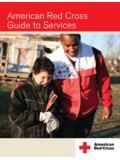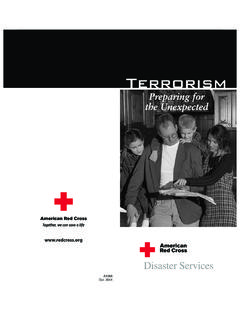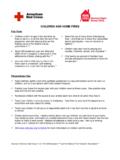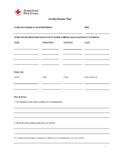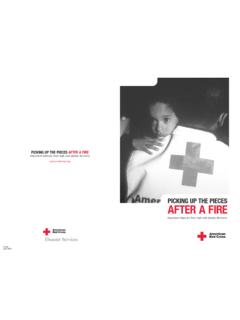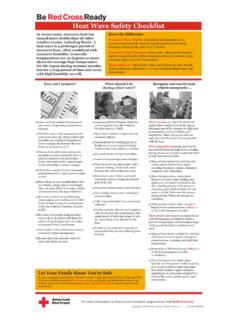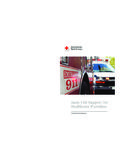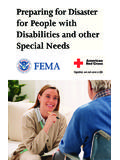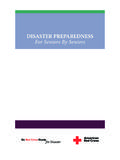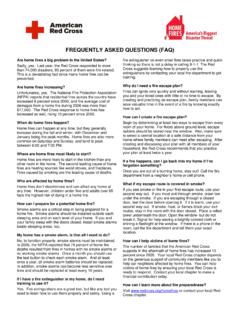Transcription of Lifeguarding - American Red Cross
1 LifeguardingLifeguarding B L E N D E D LEARNING INSTRUCTOR S MANUALL ifeguarding BLENDED LEARNING INSTRUCTOR S 19/26/12 8:54 AM Contents viiCHAPTER 1 INTRODUCTION _____ 1 Course Purpose _____ 1 Course Objectives _____ 1 Course Participants _____ 1 Instructor Responsibilities _____ 2 CHAPTER 2 COURSE DESIGN_____ 3 Course Content _____ 3 Recommended Lesson Plan _____ 3 Participant Resources _____ 4 Lifeguarding Manual _____ 4 Lifeguarding Blended eLearning _____ 4 Instructor Resources _____ 4 Lifeguarding Blended Learning Instructor s Manual _____ 4 Video Segments_____ 6 Materials, Equipment and Supplies _____ 6 Course Presentation _____ 7 Activity Worksheets _____ 7 Instructor s Corner _____ 7 Additional Resources for Instructors and Participants _____ 8 Training Equipment and Red Cross Retail Products _____ 8 Additional Red Cross Courses _____ 8 Refresher Program _____ 8 CHAPTER 3 SETTING UP AND RUNNING THIS COURSE _____ 9 Recommended Class Size _____ 9 Course Length _____ 9 Managing Participants _____ 9 Classroom Space _____ 9 Swimming Area _____ 10 Setting Up and Running Skill Sessions _____ 10 Land-Based Skill Practice _____10In-Water Skill Practice _____10 Training to the Standard.
2 But Testing to the Objective _____10 Class Safety _____ 11 Health Precautions for Course Participants _____ 11 Participants With Disabilities and Special Health Considerations _____ 12 CHAPTER 4 REQUIREMENTS FOR SUCCESSFUL COURSE COMPLETION _ _ _ _ _ _ _ _ _ _ _ _ _ _ _ _ _ _ _ _ 1 3 Criteria for Course Completion and Certifi cation _____ 13 SECTION A |ADMINISTRATIONCONTENTS viii Lifeguarding Blended Learning Instructor s ManualContinuing Education Units for Professionals _____ 14 Lifeguarding Course Outline _____ 15 Shallow Water Lifeguarding Course Outline _____ 20 Precourse Session _____ 25 Lesson Plans Lesson 1: The Professional Lifeguard _____30 Lesson 2: Facility Safety and Patron Surveillance _____37 Lesson 3: Injury Prevention _____49 Lesson 4: Water Rescue Skills _____55 Lesson 5: Before Providing Care and Victim Assessment _____68 Lesson 6: Breathing Emergencies _____78 Lesson 7: Cardiac Emergencies and Using an Automated External Defi brillator _____88 Lesson 8: First Aid _____102 Lesson 9: Head, Neck and Spinal Injuries in the Water _____118 Lesson 10.
3 Final Written Exam and Final In-Water Skill Scenarios _____126 Activity Worksheets _____ 130 ACTIVITY worksheet Reasons for the Rules _____ 130 ACTIVITY worksheet Guarding Special Attractions _____ 132 ACTIVITY worksheet Strategies for a Safe Group Visit _____ 133 ACTIVITY worksheet Using an AED in Unique Situations Fact or Fiction _____ 134 SECTION B |THE Lifeguarding AND SHALLOW WATER Lifeguarding COURSESL ifeguarding _____ 135 SECTION 1 Lifeguarding Skills Exams A and B _____ 136 Shallow Water Lifeguarding _____ 149 SECTION 1 Shallow Water Lifeguarding Skills Exams A and B _____ 150 Final Written Exam Answer Sheets _____ 162 Index _____ 165 Final Written Exam Answer KeysSECTION C | Lifeguarding FINAL WRITTEN EXAMSF inal Written Exams _____ 13 Final In-Water Skills Scenarios _____ 13 Exam Security _____ 14 Reporting Procedures _____ 14 Participant Course Evaluation _____ 14 Awarding Certifi cates _____ 14 LESSON 2 | Facility Safety and Patron Surveillance 37 Session Length: 2 hours LESSON OBJECTIVESA fter completing this lesson, participants will be able to: Describe the role lifeguards play in ensuring facility safety.
4 Identify how to ensure the safety of patrons when weather conditions create safety concerns. Explain the reasons for common rules and regulations at aquatic facilities. Describe the role that facility management plays in facility safety. Describe the drowning process. Identify the behaviors of a swimmer, a distressed swimmer, and an active and a passive victim. Identify and defi ne elements of effective surveillance. Explain proper scanning techniques and identify tactics to overcome scanning challenges. Explain and demonstrate lifeguard rotations. Demonstrate how to safely and effectively enter the water and approach a victim, and how to perform effective surveillance including scanning, victim recognition and lifeguard MATERIALS, EQUIPMENT AND SUPPLIES Activity worksheet Reasons for the Rules Diving brick(s) Stopwatch or pace clockLESSON 2 FACI LITY SAFETY AN D PATRON S U RVE I LLANCETOPIC: FACILITY SAFETYG uided Discussion Aquatic facilities must have the appropriate rescue equipment available and in proper working order at all times for emergency response.
5 As a lifeguard, you must always wear or carry certain equipment so that it is instantly available in an emergency, including a rescue tube, resuscitation mask and gloves. You also must have a whistle to signal an Ask a volunteer to come forward to demonstrate how to wear the rescue tube while in an elevated lifeguard station and a ground-level station. |The demonstration should include the following: Keep the strap of the rescue tube over the shoulder and neck. Hold or gather the excess line to keep it from getting caught in the chair or other equipment when you move or start a rescue. Hold the rescue tube across the thighs in an elevated station. Hold the rescue tube across the stomach when standing. Ask participants: Why should you wear the hip pack at all times, whether or not you are on surveillance duty? Answer: To be prepared to respond to an emergency at all times, whether or not performing surveillance : 10 minutes38 Lifeguarding Blended Learning Instructor s Manual Explain to participants that the type of rescue equipment, such as backboards, can vary among facilities and they will need to be trained to use the specific pieces of equipment at the facility where they will be employed.
6 Explain that rescue equipment can be expensive to purchase and maintain and should be treated Explain to participants that one of their most important responsibilities as a lifeguard will be to help ensure that the aquatic facility is safe. TOPIC: WEATHER CONDITIONS Guided Discussion Weather affects the safety of swimmers both outdoors and indoors. You will need to know and follow facility procedures to clear patrons from the water and deck before an impending storm. Ask participants: If thunder or lightning occurs, what should you do?Answers: Responses should include the following: |Clear everyone from the water at the first sound of thunder or first sight of lightning. If you are in an elevated station, get down immediately. Move everyone to a safe area, free from contact with water, plumbing or electrical circuits. For outdoor facilities, move everyone inside, if possible. |Keep patrons and staff out of showers and locker rooms during a thunderstorm, as water and metal can conduct electricity.
7 |Do not use a telephone connected to a landline except in an emergency. |Keep everyone away from windows and metal objects. |Watch for more storms and monitor weather reports on a radio or TV broadcast, weather radio or website. |The National Lightning Safety Institute recommends waiting 30 minutes after the last lightning sighting or sound of thunder before resuming activities. TOPIC: RULES AND REGULATIONS Activity Explain that each aquatic facility establishes its own set of rules and regulations. Some are required by the state or local health department, whereas others are determined by the facility itself. Lifeguards must know and enforce all facility rules. Explain that rules are communicated to patrons by signage as well as verbally when lifeguards enforce the rules. Divide the class into small groups. Distribute Activity worksheet Reasons for the Rules. Assign each group different sections of the worksheet . Refer participants to Chapter 2, Facility Safety, in the Lifeguarding Manual for information to help them with this activity.
8 Explain that there are five common rules for each category, or type of facility or attraction. These are not the most important rules, but rather common rules. The intent of this activity is to provide a wide range of rules so that participants gain an understanding of the rationale for different types of rules. Allow approximately 5 minutes for groups to discuss the reasoning behind the assigned rules. Reassemble the class and call on group leaders to share their : 5 minutesTime: 10 minutes LESSON 2 | Facility Safety and Patron Surveillance 39 Answers: Activity worksheet Reasons for the RulesAquatic Facilities GeneralReason1. Swim only when a lifeguard is on are inherent risks in aquatic environments, and lifeguards are trained to respond to aquatic emergencies. Statistics indicate that survival rates after emergencies are higher in areas where lifeguards are No running, pushing or rough , pushing and rough play can result in injuries, especially in an aquatic environment with slippery surfaces, such as the tile deck of an indoor Dive only in designated headfi rst in shallow water can result in head, neck and spinal No diving in shallow water (water up to 5 feet deep).
9 Diving headfi rst in shallow water can result in head, neck and spinal No glass containers in the pool area and locker glass poses several dangers, including bleeding injuries and exposure to infectious body fl No alcoholic beverages or other drug use use of alcohol and drugs can impair a patron s judgment, balance and motor Areas1. Patrons must demonstrate their swimming ability before entering deep swimming in deep water should be competent, comfortable and able to swim to the side of the pool from any spot in the deep Only one patron on the diving board at a maintaining orderly use of the diving board, such as allowing only one patron on the diving board itself and one patron on the ladder at a time, lifeguards help to create a safer environment. Patrons can get restless waiting in line, which can result in rough play on either the ladder or the diving board; a patron could slip on either the board or ladder, causing injury to him- or herself or others.
10 Allowing multiple patrons on a diving board also may affect its spring, which may result in injury for the patron using the diving Only one bounce allowed on the diving bounces on the diving board can impact balance or body control and can result in a patron slipping on the board, possibly hitting the diving board on the way Dive or jump forward, straight out from the diving areas to each side of the diving board must remain clear to prevent injury. Jumping to the side could result in striking the side of the pool or colliding with another Swim immediately to the closest ladder or the area immediately allows the next patron to use the diving board without danger to the patron in the , Hot Tubs and Therapy Pools1. Shower with soap and water before entering the temperature of the hot tub creates an environment where germs can thrive. Washing with soap and water can help keep the hot tub clean and safe for People with certain medical conditions are not allowed to use the spa or hot temperatures can stress a person s circulatory and energy systems and also can cause problems for some neurological Pregnant women and young children should seek their doctor s approval before using a spa or hot potential for hyperthermia is a danger for pregnant women and young children because they are less able to tolerate Lifeguarding Blended Learning Instructor s Manual4.
